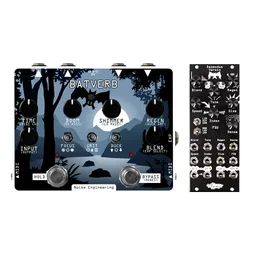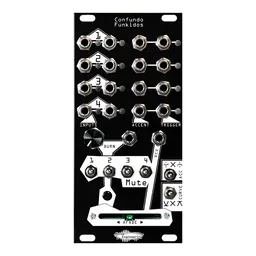We here at Noise Engineering have a pretty big line up of modules, from oscillators, to distortions (more coming…), to rhythmic utilities...and lots more. People often associate us with techno and percussion. But it turns out we like melodies too. A lot. We even like traditional, triad-based stuff (and not just the really nerdy Tonnetz-y stuff!). It’s with this interest in mind that we’re really happy to introduce you to three new modules we’ve been working on for a while that we love for pitch sequencing and utility. Meet Vox Digitalis, Quantus Pax, and Quant Gemi.

Aren’t they pretty? They’re pretty in silver, too.
Vox Digitalis: 4hp, 1-16 steps, TWO displays, a terrible abbreviation, but a whole lot of fun
A while back, we decided we wanted a small, simple, easy-to-use pitch sequencer. After LOTS of discussion, arguing, compromise, debate, and maybe a little more arguing (and a rare turn of events where Kris and Markus convinced Stephen that their design was better than his), we came up with what is now Vox Digitalis. We laughed about the name like we were 12 year olds until we realized we would have to use the abbreviation VD publicly. But by then it was too late. So here we are. Go ahead and get your giggles out. We’ll wait.
…
Done? Let’s continue! VD (snort) allows for extremely simple programming of pitch sequences of arbitrary length from 1-16 steps. Want a 6, 9, or 13 step sequence? No problem! Notes are set with the encoder, and shown on their dedicated 7-segment display. The other display shows what step you’re on. At a glance, you know exactly what’s going on in your sequence! It also has 16 save slots so you can load sequences on the fly — it has performance-oriented beat and measure-quantized pattern-loading modes, too.
Early on, we decided we wanted VD’s workflow to be as intuitive and straightforward as possible. We did our best to keep everything one-knob-per-function, but in the end we had a few features that we thought increased VD’s usefulness substantially. We argued about whether to increase the HP (and thus price) or add three simple two-key combos. We opted for the combos: change the sequence length by pressing Adv and the encoder, create a random sequence by pressing Save and the encoder, and clear a sequence by pressing Load and the encoder. No menu diving here. Just twist in your notes on each step, feed it a clock and you’re off!
It also has three different playback modes: forward, random, and pendulum. Want some random melodies in a certain scale? Program in the notes you want, plug in a clock, stick it in random and you’re off. Want a 5-step pendulum sequence à la that oldschool sequencer we all know and love? Vox Digitalis has you covered!
In development, we planned out quite a few systems using multiple Vox Digitalis’ to sequence multiple voices, and control transposition using Quantus Pax, explained later on. We’re just saying, you might enjoy having a few of these...
Check it out in action, sequencing Manis Iteritas! We change the playback modes and randomize some sequences to create a cool, quick performance.
Learn more:
Quantus Pax: a great addition to your sequencing (get it? because it’s an adder)
Precision adders are difficult, as may be suggested by the word “precision.” The human ear is so good at detecting pitch that we register even minute deviations. As a result, dealing with pitch CV can be fraught with problems. Resistors come in a wide variety of tolerances -- that is, how much error they have. Too wide a tolerance, and the resulting patch is out of tune. Of course, the more precise a part is, the more you can expect to pay for it. For more on this topic, check out the design notes in the QP manual.
We knew we wanted to create a precision adder that had a lot of bang for the buck and could do multiple things. We talked to some friends in the modular community. While Skyler King (Kittyspit) initially put the idea for a precision adder in our heads, it was a series of cocktail-fueled conversations with Bana Haffar that really informed the initial design a long time ago. We lamented that it’s really hard to work with chords in Eurorack — transposing, key changes, you name it. After our chats with Bana, we asked around and everyone had different — and complicated — workarounds to solve the problem. And so Pax Pola was born, the initial version of this module. We played with it a bit and then realized that we weren’t thrilled with the interface: for starters, we only had three channels, not four, and four-note chords are pretty baller. A chance visit with Patrick Leonard informed a whole lot of the things we wanted to do, including this module. So we revised it a bit, made it four channels, and it became Quantus Pax.
Here’s a rundown of the features: Each channel has two inputs, with the top inputs of each channel circularly normalled, so if you want to use it as a buffered mult or modify the same signal multiple times, you can! The three transpose inputs add to all four channels simultaneously. As the name would suggest, this is great for transposing multiple sequences, but we designed them with a load of uses in mind. Want to change keys in a patch? Easy to do with QP. Want to add vibrato to a four-note chord (or three-note, or to not a chord but one note)? Just patch in an LFO. Easy!
Let’s see what it can do in a patch! It’s a bit hard to tell what’s happening with all the patch cables, but Mimetic Digitalis is playing four different chords into QP. VD is then transposing those chords. Fun stuff!
Quant Gemi: active octave switch mult (that’s fun to say)
When we decided to make QP, octave switching was an obvious use we envisioned. But we became increasingly aware that octave switch options (particularly in quad) were limited. We didn’t want to have to build this feature into the QP, mainly because it would add size and cost to it (and we were trying to avoid putting any of the explicit functions into QP); also, when we looked at it, the workflow in a single module was less useful. So we came up with Quant Gemi.
Quant Gemi is simple. You’ve probably guessed by now: it lets you move up to four sequences up one or two octaves. The four inputs are also circularly normalled, so when fewer than four sequences are patched, you can use it as a buffered mult and switch octaves separately on each output (or heck, as just a really accurate buffered mult in a pinch).
But let’s use it in a patch! Here', we’re using QG in the same patch as above to move stuff around and add some variation.
How do they work together?
These four modules are powerful by themselves, but we have been sitting on a couple of them for a while because they work so incredibly well together that we thought it would be nice to put them all out at the same time.
Here are a few ideas of how we think these little modules work together as a performance-ready powerhouse (did we mention that all three fit in only 14 hp?).
VD+QP=sequenced transpose
VD is great for transposing other sequences in conjunction with QP. Use a clock divider like Horologic Solum to drive VD with a long division like /64. Program in a simple short chord progression (like C>D#>F>G#) and patch VD’s CV output to an xpose input on QP. Then, run your pitch sequences through QP’s channels and they’ll all be transposed by VD! Put the QG in the signal flow for octave switch control.
Add More!
Use a sequencer like the Tonnetz Sequent, 3-4 VDs, Mimetic Digitalis, or whatever you enjoy using to generate a chord. Patch that through QP and into QG. Use VD as above to transpose your sequence, and with the flick of a switch on QG, move notes of your chord up and down octaves.
1+2=3
Want to create related sequences from stuff you’ve already patched? Let’s say we have two sequences coming out of two VD’s, or maybe a Mimetic Digitalis. We can create a musically related but different sequence by multing those two sequences to a channel of QP and adding them together. This creates a third sequence on top of the other two! Just patch the two original sequences and your new summed sequence to three different voices and you’re off. Creative composing allows for interesting results with this sort of patch.
Run all three sequences through channels of QG before patching them to your oscillators to get even more control over octave on your voices!
Okay but show me
Check out this patch for an idea of how they work together:
Here, Mimetic Digitalis creates four chords, which are run through Quantus Pax and transposed by Vox Digitalis. Quant Gemi further transposes the lead line up one and two octaves later in the patch. Those voices are 3x Basimilus Iteritas Alter and a Manis Iteritas, triggered by Numeric Repetitor and modulated slightly by Pons Asinorum through Sinc Defero. Lots of fun stuff to be had! The really cool thing is this is just a four-step sequence on MD transposed by a five-step pendulum sequence on VD, so there’s really not much going on, even though the result is really complex.
Get ‘em while they’re hot
Quant Gemi, Quantus Pax, and Vox Digitalis are all available NOW. They look cool and sound even better. They will up your pitch-sequencing game in a big way. Ask your favorite dealer or go visit our webshop and pick up yours today. You know you want them.






